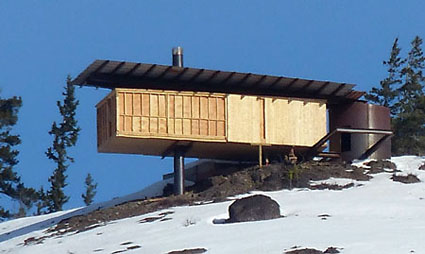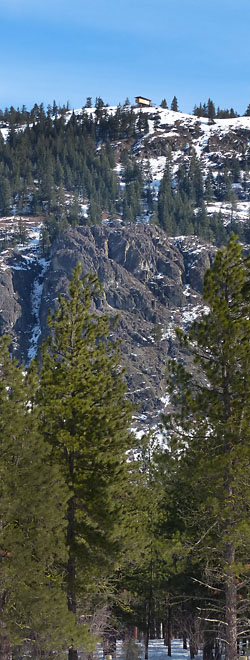home | internet service | web design | business directory | bulletin board | advertise | events calendar | contact | weather | cams

|
Flagg Hut Lawsuit The Seattle-based owners of a controversial “ridge-buster” vacation hut on Flagg Mountain in Mazama were thwarted Tuesday in their effort to have a lawsuit against them dismissed in Okanogan County Superior Court.  The controversial vacation hut on Flagg Mountain above Mazama, shown here under construction earlier this year. Photo by Sheela McLean The controversial vacation hut on Flagg Mountain above Mazama, shown here under construction earlier this year. Photo by Sheela McLeanThe suit against internationally renowned architect Tom Kundig and his wife, Jeannie, James Dow and Ben Rand was brought by valley residents Steve and Kristin Devin, John and Rayma Hayes and Lee and Theresa Miller, all former owners of the property on which the hut was built. Kundig, who designed the structure, is known locally for designing the Rolling Huts in Mazama. At issue in the case is whether the defendants illegally built the hut in violation of covenants executed by the plaintiffs in 1987 that put restrictions on placement of structures on the property. The intent of the covenants was to avoid visual pollution of the natural ridgeline at Flagg Mountain as seen from the valley floor, according to plaintiffs. According to the county’s building permit, the hut can only be used 60 days a year. But at Tuesday’s hearing before Superior Court Judge Christopher E. Culp arguments simply centered on whether the plaintiffs have legal standing to sue. Defendants’ attorney Michelle A. Green of Wenatchee, citing limiting legal precedents, argued that as the property’s former owners, the plaintiffs no longer have standing as potentially injured parties. She asked that the case be dismissed.  The hut as it appears from the valley floor near Mazama. Photo by Sheela McLean The hut as it appears from the valley floor near Mazama. Photo by Sheela McLeanGreen also argued that the covenants’ prescription that visual blight should be avoided for “lands located on the floor of the Methow Valley” is too vague and “not enforceable” because there is no legal identification in the document defining which landowners might be affected. Potentially affected property owners “must be specifically identified,” she said, citing the need for “certainty for the owners” who, lacking specific identification of such property owners, cannot fulfill their legal obligations under the covenants. Culp, who identified himself as a former resident and property owner in the Methow Valley, asked if the “valley floor” reference in the covenants could be construed to mean that anyone driving through Mazama on Highway 20 who saw the hut has standing to sue. Green said it could. “We don’t need to go there,” countered plaintiff’s attorney Claudia M. Newman of Seattle in response to arguments about the difficulty of defining a possible universe of injured parties, sight lines or a definition of the valley floor. She argued that the issue was limited to whether the plaintiff’s in this case have standing to sue as potentially injured parties. A surprise in the proceedings was the announcement that Hayes on Friday (May 24) had bought 18 percent interest in property adjoining the defendant’s hut. Culp therefore ruled that the Hayes, as adjacent landowners potentially affected by the hut, have standing to sue. “The development last Friday certainly changes things,” said Culp. “It would appear they now have a legitimate interest.” The rest of the Hayes property is owned by Jolyon Miller, who is not a party to the suit. Miller, formerly a joint owner with the plaintiffs of what is now the defendants’ property, sold the land on which the hut is built to the defendants after having bought it from the plaintiffs. Green pointed out that Hayes had bought the 18 percent interest in the property after the lawsuit was filed, but Newman countered that when Hayes bought it is immaterial. If the case were dismissed today, she told the judge, “The Hayes can re-file this case tomorrow.” Green refused to say whether she will contest the Hayes ruling. Culp also ruled that the Devins have standing, but he ruled that Lee and Theresa Miller do not meet the legal criteria. In Devins’ case, said Culp, the evidence shows that they entered into the agreement with the expectation and intention that it would protect the sight line to Flagg Mountain from their Mazama Ranch House guest ranch and other properties. “I’m glad that the court recognized the intent of the covenants,” Devin told Grist. While there is no county ordinance against building on ridge tops, the covenants say structures on the 10.5-acre property “shall be constructed with restraint and special sensitivity and consideration in order to minimize the visual impact of any such improvements on adjoining parcels and on all other lands, including lands located on the floor of the Methow Valley and all other lands which have a direct line of sight to the property.” The covenants “might have been drafted in a more artful fashion,” said Culp, whose ruling for the plaintiffs allows the legal action to proceed. Newman said the next step is to begin the discovery process. 5/28/2013 Comments
|